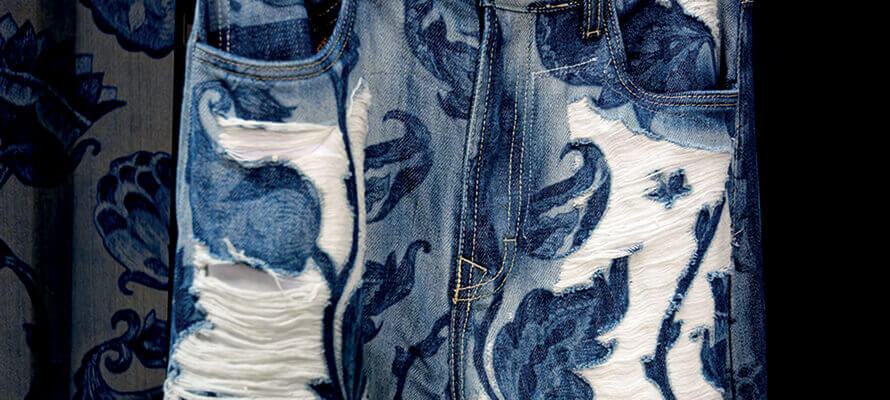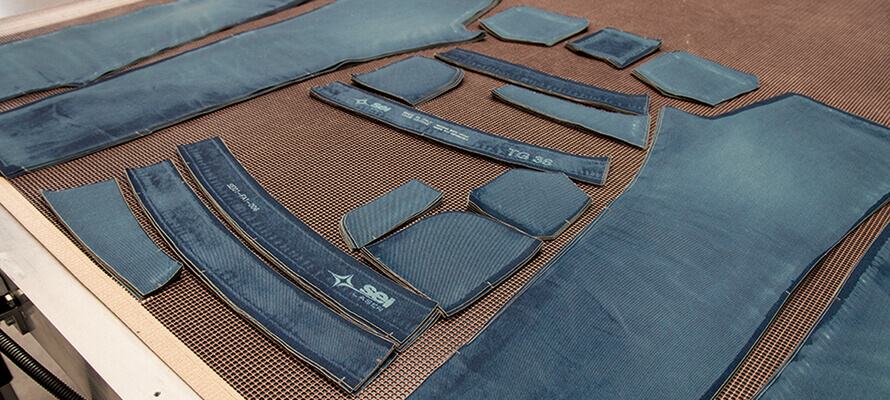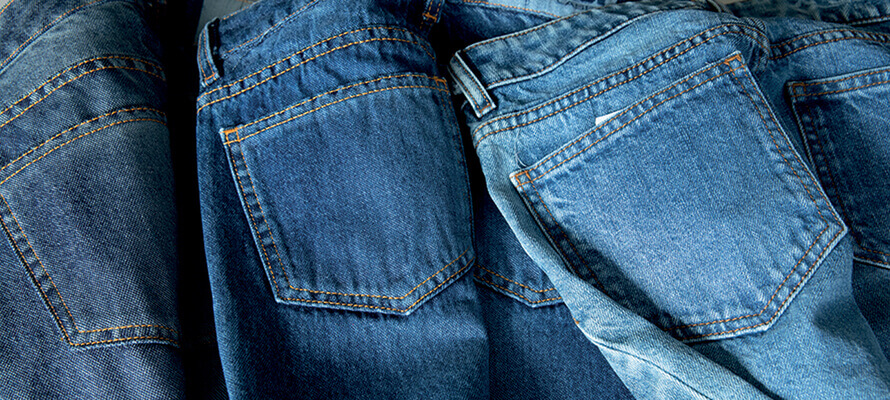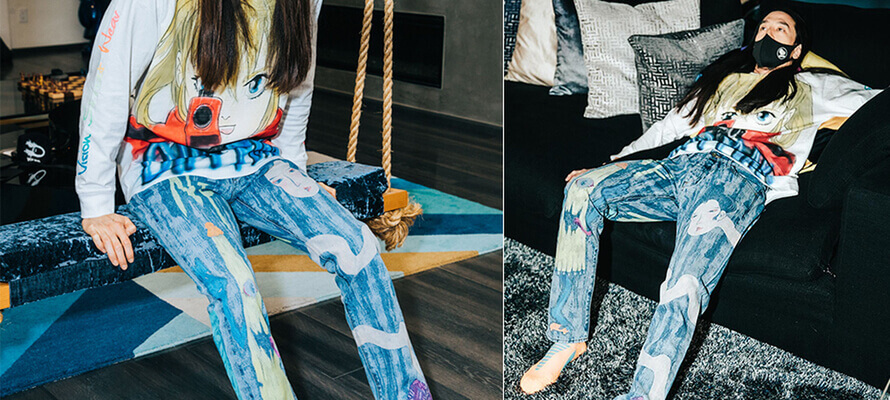Denim on demand
Technological and process innovation, which reduces the environmental impact of its production, also through the use of regenerated materials and opens up the field to customisation. The denim industry is evolving, and brands, including luxury brands, are not missing the opportunity to renew their offerings with this fabric that can boast the title of 'instant classic'.
By Caterina Pucci | On PRINTlovers 96
Perhaps you have never wondered, but the word denim comes from French, from the expression 'serge de Nîmes', which literally means fabric from Nîmes. In the 17th century, in this southern town nicknamed 'the Rome of France', cloth manufacturers had begun to make a durable fabric from cotton fibres. Being very cheap to produce, denim began to be used to make work clothes. An equally cheap pigment, indigo, was preferred to dye it, which was little used for dyeing fine garments due to its tendency to drain colour quickly. A few centuries later, the hardness and 'faded' effect would become the hallmark of one of the most iconic garments ever: blue jeans.
Also, thanks to film and music celebrities, denim has made its way into our daily lives, managing to keep its double soul intact: the one that wants it to be a poor, comfortable fabric, suitable for everyday frenetic life, and the one that has elevated it to a cornerstone of trend and glamour. 'Making jeans' using traditional techniques, however, is a very impactful process, taking up about 35% of the world's cotton production and implying a massive use of water, dyes, pesticides and chemicals. At the finishing stage, the use of techniques such as sandblasting, which is necessary to achieve the bleached effect that gives a lived-in feel to the garment, also raises an ethical question concerning the health of those who produce these fabrics.
In an attempt to find more sustainable alternatives, brands have paid more attention to digital textile printing in recent years. Improvements in the latest digital printing and finishing solutions are also leading to their progressive adoption in the denim industry. In addition to reducing consumption, among the motivations is the possibility of acquiring a new aesthetic expression and satisfying the demand of a public seeking increasingly customised and tailored products.
Reducing consumption with digital printing
Regarding consumption, traditional denim production processes are considered among the most invasive within the textile industry. In its natural state, the indigo pigment is not soluble in water, so to adhere to the substrate, the molecules must be treated with sodium hydrosulphite. The dyeing process must be repeated several times, and the yarn oxidised at each step, requiring enormous amounts of water. Several studies investigate the integration of parameters that contribute to the success of a digital print. In the case of denim, a cotton fabric with a dyed warp and slightly grey weft, it is generally agreed that the most functional process employs reactive or pigment inks.
The pandemic has accelerated the transformation of production models in the denim industry. This is demonstrated by the change of course undertaken by DenimFWD, a Californian company. Thanks to technological innovation, it is implementing a sustainable, automated and on-demand process within its Urban Factory, based in Industry, a few kilometres from Los Angeles. "Once the consumer has made the purchase, the product is finished and delivered the same day, avoiding the accumulation of warehouse stock," says Carlos Arias, CEO of DenimFWD. "This is a huge advancement in the textile industry, where 20 per cent of the garments produced are never used and end up in landfills or incinerated."
To achieve this, DenimFWD chose Jeanologia and Kornit Digital, a provider of digital printing solutions, as its technology partners. Among the printing solutions in the Urban Factory are the Kornit Atlas MAX and the new Kornit Presto MAX system, capable of printing white on dark fabrics, including denim. Thanks to these innovations, DenimFWD can now produce up to 5,000 pairs of jeans and 4,000 T-shirts per day sustainably and efficiently.
New circular fibres for made-to-measure garments
Fashion has therefore taken a sturdy, poor and humble garment and expressed it in infinite versions, ranging from faux-dirty to chic and combining the concepts of comfort and trend. Over the decades, we have witnessed the alternation of minimal lines, abundant and shapeless garments, dark and untouched canvases, and ripped and discoloured jeans. Just a few months ago, the news came out that Chanel is planning to invest in denim for the first time in the brand's history. The brand has reportedly set its sights on FashionArt SpA, an Italian company specialising in the production of jeans and high-end denim garments. Also a few months ago was the launch of the Dim Mak x Candiani EC-01 limited edition, a collaboration arising from the long-standing friendship between Steve Aoki, music producer and DJ, and Alberto Candiani, president of Candiani Denim. The company, founded in 1938 in Robecchetto con Induno, a few kilometres from Milan, as a work clothes producer, today has a turnover of €100 million with a production that extends over 200,000 square metres in the Parco del Ticino with two factories, and two research laboratories, one of which is in Los Angeles. Candiani has become a spokesperson for a 'circular' and aware approach in fashion, one of the most energy-consuming industries. This culminated in the launch of Coreva, a technology that uses vegetable yarn obtained from natural rubber instead of synthetic yarns without compromising the jeans' quality, elasticity and durability.
An important chapter in the brand's history is its entry into the B2B market, with Italy's first custom-made jeans shop opening in the centre of Milan. It sells all the brands the company collaborates with and garments made with Coreva (which currently accounts for 5% of total production). But the jewel in the crown is the micro-factory where the workers make customised garments, where you can choose fabric, style, and details. Returning to the collection with Steve Aoki, the garments are made with Re-Gen, an indigo selvedge fabric created for Candiani Denim's 80th anniversary and composed of 50% of the company's industrial waste and 50% of the TENCEL x REFIBRA fibres produced by Lenzing, which combine different recycled materials such as cotton and wood. In 2019, Re-Gen won the ITMA Sustainable Innovation Award, the most prestigious award in the textile industry. ITMA is, in fact, the world's largest trade fair for clothing textile technology. It has been held every four years since 1951 and is itinerant; the 2023 edition will take place in Milan. Candiani Denim's innovative water-saving technologies, Indigo Juice and Kitotex, suitable for enhancing the laser treatments that give the garments a special vintage effect and customised graphics, were used to dye the yarn. These innovations save water, chemicals and energy without compromising the finished products' aesthetics, quality and durability.
All's well that ends in laser
For years, lasers have been used to shorten the denim fabric processing chain, replacing invasive techniques that are hazardous to the health of operators and harmful to the environment, such as sandblasting, chemical bleaching, and milling. Using this technology, the Bergamo-based company SEI has developed several finishing solutions that optimise denim processing. "From an industrial and production perspective, processes that simulate denim wear are particularly complex to manage," explains Ivan Romano, Textile International Sales at SEI. "The traditional industrial process involves a succession of mechanical and chemical-physical phases, manual or machine abrasion, the famous stone-washing with a pumice stone, with the use of lightening substances - typically chlorine and potassium permanganate, both highly toxic. Added to this is a disproportionate use of water."
Alternatively, laser technology can be used to draw, mark, etch, cut and tear denim fabric to give a pair of jeans a faded and worn appearance or a sleek design without using aggressive conventional methods. "Using lasers, the discolouring of jeans is done quickly and offers multiple effects previously the preserve of washing techniques alone. The laser treatment uses light and heat to partially burn off the colour pigments, creating aesthetic results that can be planned in advance and replicated end-to-end," Romano adds. "Another advantage of the laser is that it does not damage fragile fibres such as stretch denim; such fibres can be affected by manual brushing or sanding." The precision of this technique can produce ultra-elaborate washing effects, imparting a worn finish and ensuring a consistent quality that is more difficult and costly to achieve with a manual washing process. "In addition, the replicability of the effect allows the design to be respected, enhances the taste and imprint of the brand, satisfies the artistic vein of the designer and at the same time favours the optimisation of resources in the factory." Laser finishing takes place at the end of the garment-making process, just before or immediately after the treatment, to remove the sticky starch-based coating, known as bozzima, which is smeared on the thread to protect it during weaving.
The lasers currently used operate on the sewn garment, which is laid on a flat surface to undergo the process, with the trousers exposed in quarters or unfolded in halves, front and back. In some cases, fitting the jeans on an inflatable, rotating dummy is preferred, allowing marking with higher precision and greater continuity between front and back. SEI has been on the market for years with its FLEXI Denim series, which operates in this conventional manner. It has recently taken a revolutionary step with the MATRIX Denim project, which allows finishing effects to be created directly on the fabric roll. Two galvanometric heads decolourise the entire surface of the patterns and cut their contours. The performance of a high-speed automatic cutting machine and that of a laser machine are combined in the same solution.
The main advantage of this treatment is that it allows areas to be reached that cannot be reached with 'traditional' laser methods, such as the inside of the back and front pockets, which usually are touched up by hand by operators using sandpaper. Laser effects can also operate on seam edges, especially when controlled breaks or fraying are to be applied: as a rule, the laser is not projected in those areas for fear of burning the sewing thread (if the thread burns, the garment has to go through some retouching stages, with increased costs, delayed delivery, and the possibility of rejection by quality control).
Previously, some particular effects, such as stone-wash on topstitching, were the exclusive prerogative of washing techniques; now, they can be predetermined in terms of positioning and intensity, with the certainty of repeatability, without errors. Added to this is the cutting function with which the outlines are marked and decorated, ready to be sent to sewing. This brings the advantage of identifying the pieces that make up the same garment, thanks to the laser engraving on the seam margins, of all the relevant information, generally printed on a label, then applied manually on each outline. It is a considerable advantage in optimising resources and access to error-free procedures. "It is as if, in a small machine, we were to add a notoriously bulky fabric cutting and laying line to a small industrial 'laundry', as many effects can be achieved directly with the laser." Among the innovative scenarios that the use of MATRIX technology could bring is the possibility of meeting time-to-market requirements. Roll-to-roll processing also opens up endless opportunities in customisation and tailor-made production. The continuous flow of fabric into the machine allows very different garments to be produced rapidly in terms of pattern, finish, effects and customisation. It's an innovation that opens the way to creating and selling made-to-measure models through web platforms, stimulating the online market, which has grown exponentially in recent years.
Towards made-to-measure production
Among the companies trying to revolutionise the design and production of jeans finishes thanks to laser technology, there is also the iconic Levi Strauss & Co., which is preparing for a major technological and production breakthrough, thanks to its Project F.L.X. technology. (Future-Led-Execution) technology. Until now, the company had relied on labour-intensive, manual techniques to produce faded elements and creases on garments, developed over about twenty steps. Thanks to the new laser-based process, Levi's was able to reduce those 'steps' to three. Where previously an inventory of jeans was built up for finishing, LS&Co. now photographs a garment and designs it in a way that the laser can interpret for application within 90 seconds. This saves a considerable amount of time it takes to make finishes on jeans, but it is also an important step in digitalising the design of those finishes. Files can, for example, be sent to retailers and quickly adapted for mass production.
Technological innovation and sustainability go hand in hand in the denim innovation path and support a change of course that embraces the 'made to measure' production model. This is also evident from recent statements by the CEO of Levi Strauss, Chip Bergh, who predicted that in ten years, the traditional model of sizing will disappear, thanks in part to the use of body scanners and cameras that allow customers to buy garments that fit their body perfectly. In the same vein is the H&M group's experimental programme, carried out by the denim & fashion brand Weekday in collaboration with H&M's innovation hub, The Laboratory, which is implementing technology to create customised jeans beyond the standard size set.






